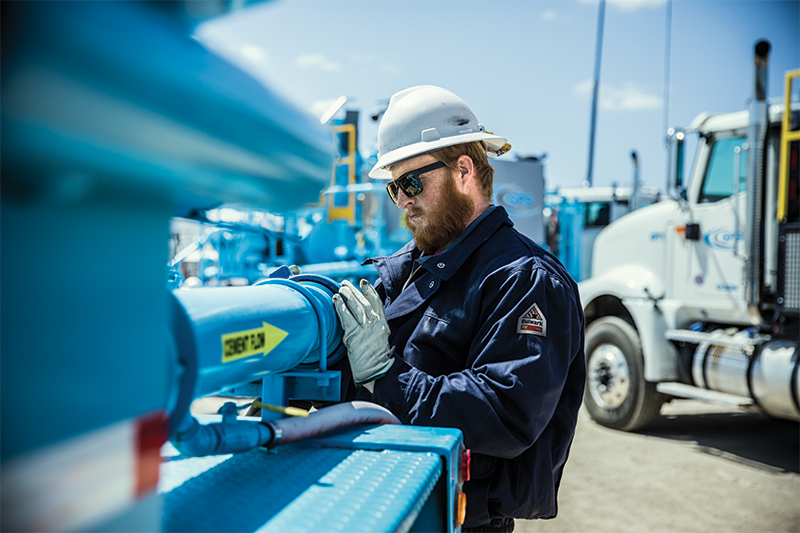
Flame-resistant (FR) clothing is a job requirement for many industries. It’s also a good idea in any situation where potential exposure to flame or sparks is a risk.
So, who wears FR clothing, anyway? Welders; contractors; employees in the oil and gas industry and anyone working with a Bunsen burner, stove or another type of open flame all require some level of flame-resistant clothing. Other industries might also find this type of clothing useful even if exposure to flames is rare or unlikely, such as electrical workers and food processors.
Considered to be a form of personal protective gear, flame-resistant clothing items may be worn at all times or donned when performing specific tasks. No matter how or when they are used, it is important that all flame-resistant garments worn on the job are not soiled, have no rips or tears and are available when needed so they can protect the wearer effectively from burns.
If you would like to get flame-resistant uniforms for employees at your place of work, Alsco can help you choose the right style for your needs.
What Is Flame-Resistant Clothing?
Flame-resistant clothing is any wearable item made from a fabric woven from fibers that will naturally stop or extinguish flames should it be exposed to fire or sparks. In some industries, it is not only recommended but required for safety. In some instances, this clothing can stop severe injury or death from occurring on the job.
Note: It’s important to note that flame-resistant clothing is extremely similar to flame- and fire-retardant clothing in effect but is materially different. Flame-resistant clothing is made of fibers that will naturally put out flames on their own, whereas fire-retardant clothing are those is made from fabric treated with chemicals that put out the flames. Fire-retardant chemicals are not as popular as they once were due to how quickly they wash out of clothing and higher levels of toxicity.
Which Flame-Resistant Clothing Is Best?
In some cases, administrative staff will be limited in the type or style of flame-resistant clothing to supply to employees based on the needs of the job. There may be some leeway for individuality and to address different issues that may have an impact on the business’s bottom line.
When looking for flame-resistant clothing for employees, it is important to consider the following criteria:
Level of protection: Depending on the work being performed by employees while wearing the garment, different levels of protection are recommended. The National Fire Protection Agency has a detailed chart available. Manufacturers of flame-resistant PPE will list the hazard risk category on the item to ensure that the item chosen offers the right level of protection.
Comfort: Comfort is a big concern when choosing flame-resistant PPE, especially if it must be worn all day, in very hot or very cold temperatures, or when doing extreme manual labor. If the garment protects against burns but causes chafing, overheats the wearer, or is so bulky that it gets in the way of completing required tasks, it’s not going to be an effective choice. Comfortable employees are not only going to be more productive, but they’ll be more likely to wear their protective gear and be happier on the job.
Maintenance: It is important to clean flame-resistant clothing according to the manufacturer’s directions so it maintains its flame-resistant properties and continues to protect the wearer. Some manufacturers have very strict guidelines for care and cleaning that will be costly for the employer or so costly for the employee that they may not be able to reasonably meet those expectations, especially if they need to wear the item daily.
Note: Hazard risk categories HRC can help employers choose the right flame-resistant articles of clothing for employees based on the hazard risk associated with the required tasks. In some cases, when employers ask employees to purchase and supply their own flame-resistant clothing, they may specify a minimum HRC, so employees know which articles to buy.
A Variety of Flame-Resistant Clothing Items Are Available
It is possible to find flame-resistant clothing that suits all types of weather conditions and addresses different issues that may be safety concerns. For example, it is possible to find flame-resistant clothing that is effective for the following situations:
Poor visibility conditions: When working outside, at night or near traffic, it is important to provide employees with FR outwear that is highly visible.
Rain, sleet and snow: It is possible to have FR outerwear items that not only deflect the rain and snow but are resistant to flames as well.
Extreme cold: Heavy coats that keep the wearer warm while protecting against burns are available in a variety of fabrics, including FR.
High heat: Lightweight flame-resistant fabrics are available as well, protecting employees who have to wear the gear in high temperatures or in the hot sun.
Note: If employees need to wear a uniform that has an embroidered logo or name tag on it, it is possible to have this made using flame-resistant thread.
Alsco Can Help Businesses Develop Their Flame-Resistant Uniform Programs
If your employees need flame-resistant uniforms, and you need assistance making sure that the uniforms look good and are maintained in such a way as to preserve their flame resistance, Alsco can help.
Learn more about how we can help administration staff protect employees with the right flame-resistant uniforms when you contact Alsco today.
References
Flame-Resistant Clothing: Everything You Need to Know. (February 2021). Power.
Standard on Flame-Resistant Clothing for Protection of Industrial Personnel Against Short-Duration Thermal Exposures from Fire. (2023 Edition). National Fire Protection Association.
